Cars, Cars, and Cars
Prev
Next


|
Day 2: May 25, 2008 Cars, Cars, and Cars |
Prev Next |
 
|
|
|


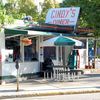 I somehow ended the day in Auburn with the idea of at least seeing the
museum there in the morning before heading further west to the Studebaker
museum. But I knew I'd be passing within a mile of a Hudson museum that
it really seemed a shame to miss. So I did some searchin' and cipherin'.
The Auburn museum would open at 9:00 and so would the Hudson one. The
Studebaker museum would be open from noon to 5:00. If I was at the first
museum when it opened and spent an average of two hours at each museum, I
coule see all three with two hours travel time left over. DeLorme
estimated the drive at 2:13 so the plan seemed feasible. Just how many
cars can one man see in a day, anyway? Then I ciphered some more. Fort
Wayne was only a half-hour away and Cindy's would be open at 7:00 (6:00
every day but Sunday) so it was just possible that I could see three auto
museums and eat at a classic diner, too. I am truly blessed.
I somehow ended the day in Auburn with the idea of at least seeing the
museum there in the morning before heading further west to the Studebaker
museum. But I knew I'd be passing within a mile of a Hudson museum that
it really seemed a shame to miss. So I did some searchin' and cipherin'.
The Auburn museum would open at 9:00 and so would the Hudson one. The
Studebaker museum would be open from noon to 5:00. If I was at the first
museum when it opened and spent an average of two hours at each museum, I
coule see all three with two hours travel time left over. DeLorme
estimated the drive at 2:13 so the plan seemed feasible. Just how many
cars can one man see in a day, anyway? Then I ciphered some more. Fort
Wayne was only a half-hour away and Cindy's would be open at 7:00 (6:00
every day but Sunday) so it was just possible that I could see three auto
museums and eat at a classic diner, too. I am truly blessed.
Cindy's was just as cool as I expected and I got a shot of John bringing me my breakfast with one of the fully functional juke box consoles visible in the picture. A couple of twenty-something guys sat down next to me and flipped through the musical selections commenting on several he'd never heard of. I donated a quarter so he could hear Purple People Eater for the first time. I'm not sure he believed me when I told him the fellow singing had a street named after him in Oklahoma but he was polite. The soon to be closed Lincoln Museum was just blocks away so I stopped by even though it would not open until noon and I had no extra time, anyway. The website is no longer accepting orders but you have until June 30 to take advantage of the going out of business sale. Save 40%. |
|
|
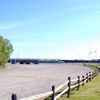
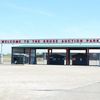 My path back to Auburn took me past the Kruze Auction site where lots of classic vehicles and
lots of classic currency change hands.
My path back to Auburn took me past the Kruze Auction site where lots of classic vehicles and
lots of classic currency change hands.
|
|
|
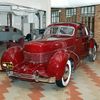
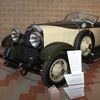
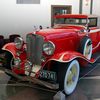
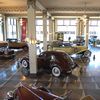
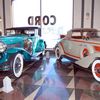
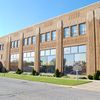 Ask anyone about classic cars and if Auburns, Cords, or Duesenbergs aren't
in the first two or three examples they give, you can probably ignore what
ever they do say. Those three marks are almost the very definition of
"classic" and the company that manufactured all three was
headquartered here. The building that once held offices, design studios,
and a showroom now holds the Auburn-Cord-Duesenberg Museum and is a
National Historic
Landmark. The first picture shows a 1930 Duesenberg Model J (265 HP
in 1930!) and a 1936 Auburn Cabriolet. 1936 was the last year Auburns were
made and this car would have sold for about $945 when new. The fourth and
fifth pictures show Auburns. The first, a 1933 model, and the second, a
1929 Boattail Speedster. The last picture is of 1936 Cord. The 1936 Cord
has been called "America's most beautiful automobile" and this
one actually belonged to its designer, Gordon Buehrig.
Ask anyone about classic cars and if Auburns, Cords, or Duesenbergs aren't
in the first two or three examples they give, you can probably ignore what
ever they do say. Those three marks are almost the very definition of
"classic" and the company that manufactured all three was
headquartered here. The building that once held offices, design studios,
and a showroom now holds the Auburn-Cord-Duesenberg Museum and is a
National Historic
Landmark. The first picture shows a 1930 Duesenberg Model J (265 HP
in 1930!) and a 1936 Auburn Cabriolet. 1936 was the last year Auburns were
made and this car would have sold for about $945 when new. The fourth and
fifth pictures show Auburns. The first, a 1933 model, and the second, a
1929 Boattail Speedster. The last picture is of 1936 Cord. The 1936 Cord
has been called "America's most beautiful automobile" and this
one actually belonged to its designer, Gordon Buehrig.
|
|
|
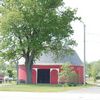
 Some scenes from US-20 between museums. I also drove a wee bit (<
2 miles) of US-6 as I left Auburn.
Some scenes from US-20 between museums. I also drove a wee bit (<
2 miles) of US-6 as I left Auburn.
|
|
|
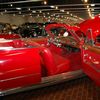

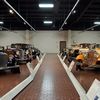
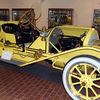

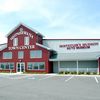 Next up is the Hostetler collection of Hudsons in Shipshewana. The
green car is from 1909, the company's first year of production. The yellow
1911 Speedster was actually built to promote Hudson sales in Puerto Rico
and spent many years rusting there before being restored in 1991. The dark
red car in the next to last photo is a genuine 1933 Terraplane
Convertible. No doubt that "when I mash down on your little starter
then your spark plug will give me fire". I liked the '51 convertible
in the last picture so much that I've included a couple of other views
here and here.
Next up is the Hostetler collection of Hudsons in Shipshewana. The
green car is from 1909, the company's first year of production. The yellow
1911 Speedster was actually built to promote Hudson sales in Puerto Rico
and spent many years rusting there before being restored in 1991. The dark
red car in the next to last photo is a genuine 1933 Terraplane
Convertible. No doubt that "when I mash down on your little starter
then your spark plug will give me fire". I liked the '51 convertible
in the last picture so much that I've included a couple of other views
here and here.
|
|
|
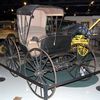
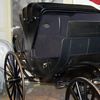
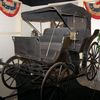
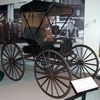
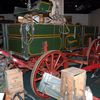 This 1857 Studebaker Phaeton is the oldest known vehicle from that company
that got its start building wagons and carriages in 1854. Studebaker
carriages were everywhere including presidential stables. Second picture
is of the carriage that carried Lincoln to Ford's Theater for a play he
did not see the end of. The next carriage pictured belonged to McKinley
who rode it to a Canton, Ohio, station for a train ride that apparently
went quite smoothly but took him to Buffalo, New York, where his assassin
awaited. The remaining pictures are of the last buggy (1919) and last farm
wagon (1920) built by Studebaker.
This 1857 Studebaker Phaeton is the oldest known vehicle from that company
that got its start building wagons and carriages in 1854. Studebaker
carriages were everywhere including presidential stables. Second picture
is of the carriage that carried Lincoln to Ford's Theater for a play he
did not see the end of. The next carriage pictured belonged to McKinley
who rode it to a Canton, Ohio, station for a train ride that apparently
went quite smoothly but took him to Buffalo, New York, where his assassin
awaited. The remaining pictures are of the last buggy (1919) and last farm
wagon (1920) built by Studebaker.
|
|
|
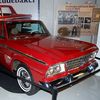
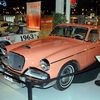
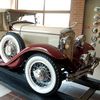
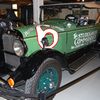
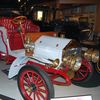
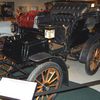 Studebaker manufactured electric cars from 1902 through 1911 but started
building gasoline powered models in 1904. The first car here is a 1907
Electric Runabout; The second, a 1904 Model C. This Model C is the oldest
surviving gasoline powered Studebaker vehicle. Covering 25,000 miles in
less than 23,000 minutes in a 1928 Big 6 Commander certainly helped sales
and might have even helped sell this gorgeous 1931 Model 54.
Studebaker manufactured electric cars from 1902 through 1911 but started
building gasoline powered models in 1904. The first car here is a 1907
Electric Runabout; The second, a 1904 Model C. This Model C is the oldest
surviving gasoline powered Studebaker vehicle. Covering 25,000 miles in
less than 23,000 minutes in a 1928 Big 6 Commander certainly helped sales
and might have even helped sell this gorgeous 1931 Model 54.
Yeah, '57 Chevys look great and two-seater T-Birds are really cool but it's hard to beat a Hawk. This 1961 specimen has A/C, four-on-the-floor, and Flamingo factory paint. Check out the interior. The red Daytona is the last Studebaker built in South Bend. Production continued for a couple more years in Canada but 114 years of vehicle manufacturing ended for Studebaker on March 17, 1966. |
|
|
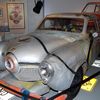 I'm closing the day with a personal favorite. It's the only "bullet
nose" I've posted but it's not just any "bullet nose". It's
the Muppet's "bullet nose".
I'm closing the day with a personal favorite. It's the only "bullet
nose" I've posted but it's not just any "bullet nose". It's
the Muppet's "bullet nose".
Movin' right along, foot-loose and fancy free. |
|
|
| [Prev] [Site Home] [Trip Home] [Contact] [Next] |